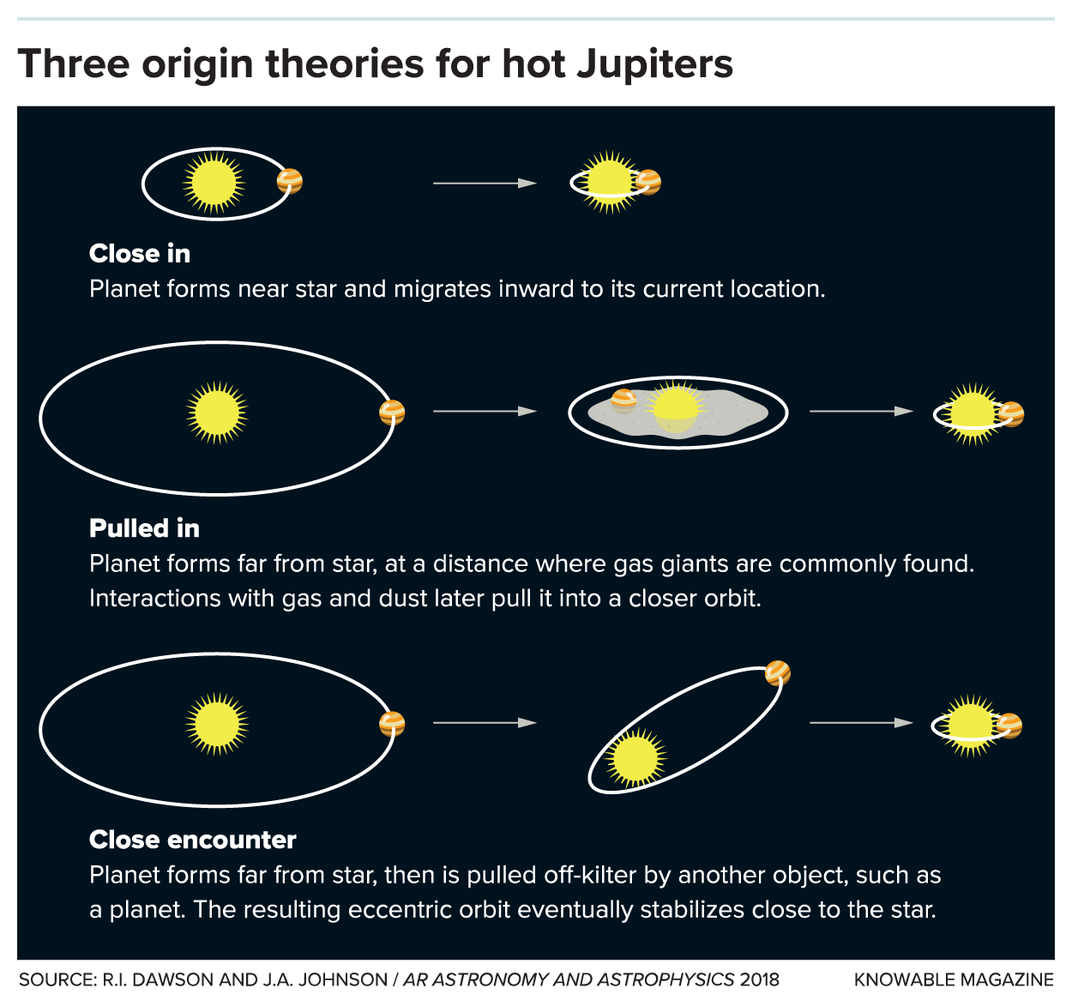What Astronomers Can Learn From Hot Jupiters, the Scorching Giant Planets of the Galaxy – Smithsonian
In 1995, after years of effort, astronomers made an announcement: They’d found the first planet circling a sun-like star outside our solar system. But that planet, 51 Pegasi b, was in a quite unexpected place — it appeared to be just around 4.8 million miles away from its home star and able to dash around the star in just over four Earth-days. Our innermost planet, Mercury, by comparison, is 28.6 million miles away from the sun at its closest approach and orbits it every 88 days.
What’s more, 51 Pegasi b was big — half the mass of Jupiter, which, like its fellow gas giant Saturn, orbits far out in our solar system. For their efforts in discovering the planet, Michel Mayor and Didier Queloz were awarded the 2019 Nobel Prize for Physics alongside James Peebles, a cosmologist. The Nobel committee cited their “contributions to our understanding of the evolution of the universe and Earth’s place in the cosmos.”
The phrase “hot Jupiter” came into parlance to describe planets like 51 Pegasi b as more and more were discovered in the 1990s. Now, more than two decades later, we know a total of 4,000-plus exoplanets, with many more to come, from a trove of planet-seeking telescopes in space and on the ground: the now-defunct Kepler; and current ones such as TESS, Gaia, WASP, KELT and more. Only a few more than 400 meet the rough definition of a hot Jupiter — a planet with a 10-day-or-less orbit and a mass 25 percent or greater than that of our own Jupiter. While these close-in, hefty worlds represent about 10 percent of the exoplanets thus far detected, it’s thought they account for just 1 percent of all planets.
Still, hot Jupiters stand to tell us a lot about how planetary systems form — and what kinds of conditions cause extreme outcomes. In a 2018 paper in the Annual Review of Astronomy and Astrophysics, astronomers Rebekah Dawson of the Pennsylvania State University and John Asher Johnson of Harvard University took a look at hot Jupiters and how they might have formed — and what that means for the rest of the planets in the galaxy. Knowable Magazine spoke with Dawson about the past, present and future of planet-hunting, and why these enigmatic hot Jupiters remain important. This conversation has been edited for length and clarity.

What is a hot Jupiter?
A hot Jupiter is a planet that’s around the mass and size of Jupiter. But instead of being far away from the sun like our own Jupiter, it’s very close to its star. The exact definitions vary, but for the purpose of the Annual Review article we say it’s a Jupiter within about 0.1 astronomical units of its star. An astronomical unit is the distance between Earth and the sun, so it’s about 10 times closer to its star — or less — than Earth is to the sun.
What does being so close to their star do to these planets?
That’s an interesting and debated question. A lot of these hot Jupiters are much larger than our own Jupiter, which is often attributed to radiation from the star heating and expanding their gas layers.
It can have some effects on what we see in the atmosphere as well. These planets are tidally locked, so that the same side always faces the star, and depending on how much the heat gets redistributed, the dayside can be much hotter than the nightside.
Some hot Jupiters have evidence of hydrogen gas escaping from their atmospheres, and some particularly hot-hot Jupiters show a thermal inversion in their atmosphere — where the temperature increases with altitude. At such high temperatures, molecules like water vapor and titanium oxide and metals like sodium and potassium in the gas phase can be present in the atmosphere.
What might explain how a planet ends up so close to its star?
There are three categories of models that people have come up with. One is that maybe these planets form close to their stars to begin with. Originally, people sort of dismissed this. But more recently, astronomers have been taking this theory a bit more seriously as more studies and simulations have shown the conditions under which this could happen.
Another explanation is that during the stage when the planetary system was forming out of a disk of gas and dust, the Jupiter was pulled in closer to its star.
The last explanation is that the Jupiter could have started far away from the star and then gotten onto a very elliptical orbit — probably through gravitational interactions with other bodies in the system — so that it passed very close to the host star. It got so close that the star could raise strong tides on the Jupiter, just like the moon raises tides on the Earth. That could shrink and circularize its orbit so that it ended up close to the star, in the position we observe.

Are there things we see in the planetary systems that have hot Jupiters that other systems don’t have?
There are some trends. One is that most hot Jupiters don’t have other small planets nearby, in contrast to other types of planetary systems we see. If we see a small hot planet, or if we see a gas giant that’s a bit farther away from its star, it often has other planets nearby. So hot Jupiters are special in being so lonely.
The loneliness trend ties in to how hot Jupiters formed so close to their stars. In the scenario where the planet gets onto an elliptical orbit that shrinks and circularizes, that would probably wipe out any small planets in the way. That said, there are a few systems where a hot Jupiter does have a small planet nearby. With those, it’s not a good explanation.
Planetary systems with hot Jupiters often have other giant planets in the system farther away — out beyond where the Earth is, typically. Perhaps, if hot Jupiters originated from highly eccentric orbits, those faraway planets are responsible for exciting their eccentricities to begin with. Or there could have been responsible planets that got ejected from the system in the process, so we don’t necessarily have to still see them in the system.
Another big trend is that hot Jupiters tend to be around stars that are more metal-rich. Astronomers refer to metals as any element heavier than hydrogen or helium. There’s more iron and other elements in the star, and we think that this may affect the disk of gas and dust that the planets formed out of. There are more solids available, and that could facilitate forming giant planets by providing material for their cores, which would then accrete gas and become gas giants.
Having more metals in the system could enable the creation of multiple giant planets. That could cause the type of gravitational interaction that would put the hot Jupiter onto a high eccentricity orbit.
Hot Jupiters like 51 Pegasi b were the first type of planet discovered around sun-like stars. What led to their discovery?
It occurred after astronomers started using a technique called the radial velocity method to look for extrasolar planets. They expected to find analogs to our own Jupiter, because giant planets like this would produce the biggest signal. It was a very happy surprise to find hot Jupiters, which produce an even larger signal, on a shorter timescale. It was a surprising but fortuitous discovery.
Can you explain the radial velocity method?
It detects the motion of the host star due to the planet. We often think of stars sitting still and there’s a planet orbiting around it. But the star is actually doing its own little orbit around the center of mass between the two objects, and that’s what the radial velocity method detects. More specifically, it detects the doppler shift of the star’s light as it goes in its orbit and moves towards or away from us.
One of the other common ways to find planets is the transit method, which looks for the dimming of a star’s light due to a planet passing in front of it. It’s easier to find hot Jupiters than smaller planets this way because they block more of the star’s light. And if they are close to the star they transit more frequently in a given period of time, so we’re more likely to detect them.
In the 1990s, many of the exoplanets astronomers discovered were hot Jupiters. Since then, we’ve found more and different kinds of planets — hot Jupiters are relatively rare compared with Neptune-sized worlds and super-Earths. Why is it still important to find and study them?
One big motivation is the fact that they’re out there and that they weren’t predicted from our theories of how planetary systems form and evolve, so there must be some major pieces missing in those theories.
Those missing ingredients probably affect many planetary systems even if the outcome isn’t a hot Jupiter — a hot Jupiter, we think, is probably an extreme outcome. If we don’t have a theory that can make hot Jupiters at all, then we’re probably missing out on those important processes.
A helpful thing about hot Jupiters is that they are a lot easier to detect and characterize using transits and radial velocity, and we can look at the transit at different wavelengths to try to study the atmosphere. They are really helpful windows into planet characterization.
Hot Jupiters are still going to always be the planets we can probe in the most detail. So even though people don’t necessarily get excited about the discovery of a new hot Jupiter anymore, increasing the sample lets us gather more details about their orbits, compositions, sizes or what the rest of their planetary system looks like, to try to test theories of their origins. In turn, they’re teaching us about processes that affect all sorts of planetary systems.
What questions are we going to be able to answer about hot Jupiters as the next-generation observatories come up, such as the James Webb Space Telescope and larger ground-based telescopes?
With James Webb, the hope is to be able to characterize a huge number of hot Jupiters’ atmospheric properties, and these might be able to help us test where they formed and what their formation conditions were like. And my understanding is that James Webb can study hot Jupiters super quickly, so it could get a really big sample of them and help statistically test some of these questions.
The Gaia mission will be really helpful for characterizing the outer part of their planetary systems and in particular can help us measure whether massive and distant planets are in the same plane as a transiting hot Jupiter; different theories predict differently on whether that should be the case. Gaia is very special in being able to give us three-dimensional information, when usually we have only a two-dimensional view of the planetary system.
TESS [the Transiting Exoplanet Survey Satellite space telescope] is going on right now — and its discoveries are around really bright stars, so it becomes possible to study the whole system that has a hot Jupiter using the radial velocity method to better characterize the overall architecture of the planetary system. Knowing what’s farther out will help us test some of the ideas about hot Jupiter origins.
TESS and other surveys also have more young stars in the sample. We can see what the occurrence rate and properties are of hot Jupiters closer to when they formed. That, too, will help us distinguish between different formation scenarios.
They’re alien worlds to us, but what can hot Jupiters tell us about the origins of our own solar system? These days, many missions are concentrating on Earth-sized planets.
What we’re all still struggling to see is: Where does our solar system fit into a bigger picture of how planetary systems form and evolve, and what produces the diversity of planetary systems we see? We want to build a very complete blueprint that can explain everything from our solar system, to a system with hot Jupiters, to a system more typical of what [the retired space telescope] Kepler found, which are compact, flat systems of a bunch of super-Earths.
We still don’t have a great explanation for why our solar system doesn’t have a hot Jupiter and other solar systems do. We’d like some broad theory that can explain all types of planetary systems that we’ve observed. By identifying missing processes or physics in our models of planet formation that allow us to account for hot Jupiters, we’re developing that bigger picture.
Do you have any other thoughts?
The one thing I might add is that, as we put together all the evidence for our review, we found that none of the theories can explain everything. And that motivates us to believe that there’s probably multiple ways to make a hot Jupiter — so it’s all the more important to study them.
Knowable Magazine is an independent journalistic endeavor from Annual Reviews.








